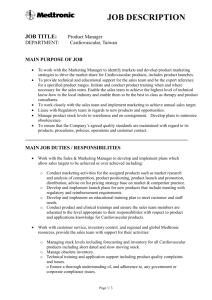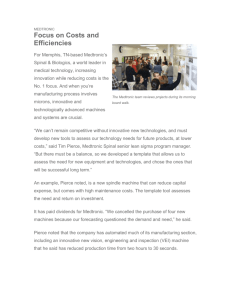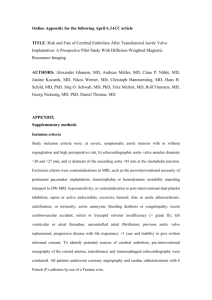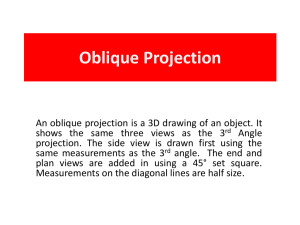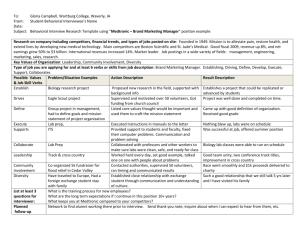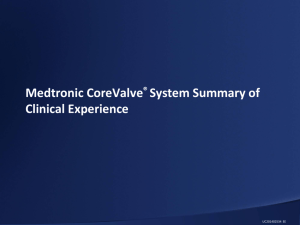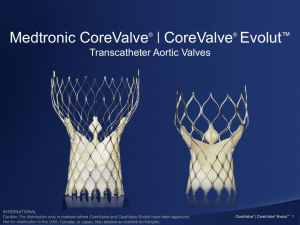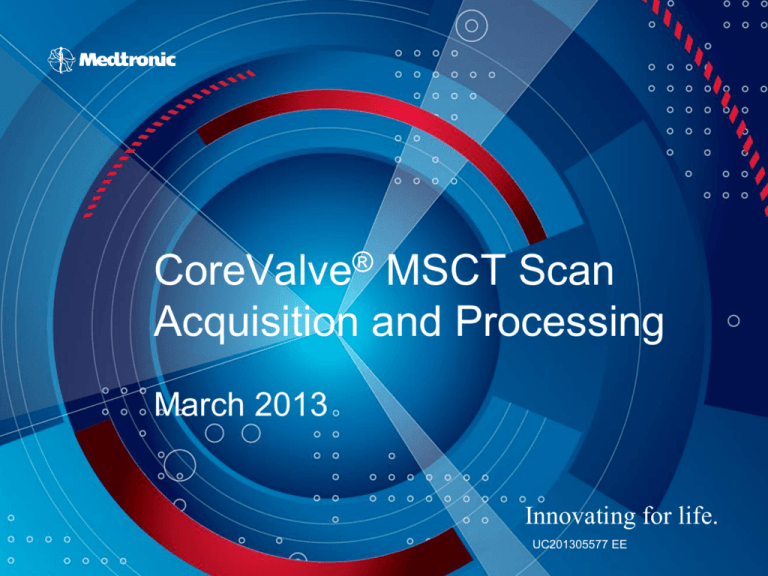
CoreValve® MSCT Scan
Acquisition and Processing
March 2013
Innovating for life.
UC201305577 EE
The MSCT Sizing Process
The sizing process includes three main parts, all of equal
importance:
– Proper image acquisition and post-processing
– Reformatting of the aortic root and preparation for measurement
– Aortic root measurements and device selection (covered earlier
in presentation)
Academia
Medical Education
INTERNATIONAL. CAUTION: For distribution only in markets where CoreValve® is
approved. Not for distribution in U.S. or Japan. Medtronic, Inc. 2013. All Rights Reserved.
MSCT Scan Acquisition
Academia
Medical Education
INTERNATIONAL. CAUTION: For distribution only in markets where CoreValve® is
approved. Not for distribution in U.S. or Japan. Medtronic, Inc. 2013. All Rights Reserved.
Equipment Required
Multi-detector CT scanner (64-slice minimum) with ECGgating capability.
– The scans of the aortic root MUST be ECG-gated.
Non-gated scans in areas with cardiac motion lead to measurement
inaccuracy and therefore incomplete information for device selection.
– Peripheral vessel image acquisition may be non-gated.
Post-processing software capable of MPR and standard
measurements (diameter, area, perimeter)
– This is typically standard on most imaging system workstations
– This is also available on many second party applications
Academia
Medical Education
INTERNATIONAL. CAUTION: For distribution only in markets where CoreValve® is
approved. Not for distribution in U.S. or Japan. Medtronic, Inc. 2013. All Rights Reserved.
Scans Required
1. Chest topogram
2. ECG-gated contrast enhanced aortic root
3. Non ECG-gated contrast enhanced peripheral vessels
Sub-millimeter slice thickness is required for scans 2 and 3
Academia
Medical Education
INTERNATIONAL. CAUTION: For distribution only in markets where CoreValve® is
approved. Not for distribution in U.S. or Japan. Medtronic, Inc. 2013. All Rights Reserved.
Scanning Procedures
• The scan protocol is similar to a CT coronary
angiogram.
• The aim is to get adequate contrast in the region of
interest (i.e., endo-luminal surface) for visualization of
left heart, aorta, and peripheral access vessels (i.e.,
femorals and subclavians) when necessary.
• Temporal resolution should be optimized to reduce
motion artifact.
• Spatial resolution should be as high as possible (goal is
smallest isotropic voxel size for high-quality MPR).
Academia
Medical Education
INTERNATIONAL. CAUTION: For distribution only in markets where CoreValve® is
approved. Not for distribution in U.S. or Japan. Medtronic, Inc. 2013. All Rights Reserved.
Step 1: Patient Preparation
• Administer medication per institution standard practice
for CT scanning.
• Attach ECG electrodes for gating of scan. Verify quality
of ECG tracing on scanner console.
• Prepare large intravenous line (18 or 20 gauge) for
administration of contrast media.
• Instruct patient to lie still during scan, even if they
experience warmth or tingling due to the injection of
contrast.
• Instruct patient in practice of breath-hold at endinspiration for 10-15 seconds (duration required will
depend on specific scanner performance). Assess heart
rate variability during breath-hold. If heart rate is >65
bpm or unstable, consider titration of beta-blockers.
Academia
Medical Education
INTERNATIONAL. CAUTION: For distribution only in markets where CoreValve® is
approved. Not for distribution in U.S. or Japan. Medtronic, Inc. 2013. All Rights Reserved.
Step 2: Topogram
Acquire a chest topogram for use in planning the
imaging protocol.
Academia
Medical Education
INTERNATIONAL. CAUTION: For distribution only in markets where CoreValve® is
approved. Not for distribution in U.S. or Japan. Medtronic, Inc. 2013. All Rights Reserved.
Step 3: Contrast Enhanced Scan Parameters
• Intent: Assessment of aortic root and valve anatomy
• Coverage area
– Suggested: Superior to aortic arch - inferior to cardiac apex
– Minimum: 10 mm below aortic annulus – 70 mm above aortic
annulus (includes the aortic root and direct aortic access)
• Retrospective or prospective ECG-gating may be used
Reconstruct or trigger in systole
• Required detector collimation of 0.4 – 0.625 mm
• Required slice thickness of < 1 mm
• Recommended slice overlap of 0.4 mm
Academia
Medical Education
INTERNATIONAL. CAUTION: For distribution only in markets where CoreValve® is
approved. Not for distribution in U.S. or Japan. Medtronic, Inc. 2013. All Rights Reserved.
Recommended Coverage Area
Minimum
Coverage
Area
Academia
Medical Education
INTERNATIONAL. CAUTION: For distribution only in markets where CoreValve® is
approved. Not for distribution in U.S. or Japan. Medtronic, Inc. 2013. All Rights Reserved.
Step 3: ECG-Gated, Contrast Enhanced Scan
Execution
•
•
•
•
•
•
•
•
Prepare iodinated contrast injection apparatus.
Set up scan parameters per the table on slide 17.
Instruct patient to lie still during scan, even if they experience warmth or
tingling due to the injection of contrast.
Initiate contrast injection.
When contrast reaches threshold at bolus-tracking location, instruct patient
to hold breath at end-inspiration, then initiate main scan protocol.
At completion of scan verify images are of adequate quality.
Record amount of contrast given.
Record heart rate average and range.
Academia
Medical Education
INTERNATIONAL. CAUTION: For distribution only in markets where CoreValve® is
approved. Not for distribution in U.S. or Japan. Medtronic, Inc. 2013. All Rights Reserved.
Step 4: Post-processing of Aortic Root Images
•
Verify heart rate ECG triggers are at consistent place in cardiac cycle, edit
if necessary. Additional editing/removal of arrhythmias may be performed.
•
If retrospective gating is used:
–
–
–
Reconstruct the cleanest systolic phase from a signal-noise ratio and motion artifact
perspective.
Automated “best-systolic” reconstruction can also be used.
< 1 mm slice thickness with small overlap
Academia
Medical Education
INTERNATIONAL. CAUTION: For distribution only in markets where CoreValve® is
approved. Not for distribution in U.S. or Japan. Medtronic, Inc. 2013. All Rights Reserved.
ECG-Gated, Contrast Enhanced Scan Parameters
Recommended Parameters
IV injection with
iodine contrast
80-100 (320mg/ml or higher), modify per patient as appropriate
Injection rate
Bolus tracking, delay
4-6 mL/sec
Delay time calculated using protocol for current scanner (bolus tracking or similar) with peak of
contrast concentration in the ascending aorta during acquisition.
ECG Leads
Required
ECG-gating
Prospective or Retrospective
Scan direction
Cranial-caudal
Scan coverage
From above the aortic arch to past the cardiac apex
0.4 – 0.625 mm
Detector collimation
Pitch
0.2–0.43 adapted to the heart rate
Dose modulation
If retrospective, modulation and full current between 30 and 80% of the cardiac cycle
Slice thickness
0.8 mm
Slice overlap
0.4 mm
Reconstruction
kernel
Post-processing
Medium Smooth
Reconstruct the cleanest systolic phase from a signal-noise ratio and motion artifact perspective.
Automated “best-systolic” reconstruction can also be used.
Reconstructed slice thickness <1 mm.
Academia
Medical Education
INTERNATIONAL. CAUTION: For distribution only in markets where CoreValve® is
approved. Not for distribution in U.S. or Japan. Medtronic, Inc. 2013. All Rights Reserved.
Step 5: Non-gated, Contrast-Enhanced Scan of the
Peripheral Access Vessels
•
•
•
•
•
Intent: Assessment of peripheral access vessels
Standard radiology CT angiography protocol
Non ECG-gated
Delay time calculated using protocol for current scanner (i.e., bolus
tracking) with peak of contrast concentration in the area of interest
Suggested coverage areas:
– Femoral access only screening: abdominal aorta above celiac artery and down
to the femoral head
– Subclavian access only screening: above the subclavian arteries and down to
mid-thorax
– Combined access screening: above the subclavian arteries and down to the
femoral head
•
Source data reconstructed using < 1 mm slice thickness with small overlap
Academia
Medical Education
INTERNATIONAL. CAUTION: For distribution only in markets where CoreValve® is
approved. Not for distribution in U.S. or Japan. Medtronic, Inc. 2013. All Rights Reserved.
MSCT Scan Processing
Academia
Medical Education
INTERNATIONAL. CAUTION: For distribution only in markets where CoreValve® is
approved. Not for distribution in U.S. or Japan. Medtronic, Inc. 2013. All Rights Reserved.
Proper Aortic Annulus Measurements
• The aortic annulus is not co-planar with the planes of the body (i.e.,
axial, sagittal, or coronal).
• Therefore, multi-planar reformatting of the CT images is required to
create a double-oblique axial image for annulus measurements.
• This reformatting is critical; if the plane is not correctly aligned, it
may be passing through the sinuses or the LVOT. This can lead to
improper device selection.
• This reformatting is also used in assessing the measurements for
the rest of the aortic root (sinus width, height and ascending aorta
diameters).
• The following methods are similar to those reported in Schultz et al.
EuroIntervention Supplement (2010) Volume 6 (Supplement G) G6G13.
Academia
Medical Education
INTERNATIONAL. CAUTION: For distribution only in markets where CoreValve® is
approved. Not for distribution in U.S. or Japan. Medtronic, Inc. 2013. All Rights Reserved.
Step 1: Multiplanar Reformat
Coronal
Axial
Sagittal
3D
Example images in original orientation (axial, coronal and sagittal). Red curved arrow and line indicate
adjustment of coronal and sagittal planes to align with aortic annular plane.
Academia
Medical Education
INTERNATIONAL. CAUTION: For distribution only in markets where CoreValve® is
approved. Not for distribution in U.S. or Japan. Medtronic, Inc. 2013. All Rights Reserved.
Step 2: Verify Aortic Annular Plane
Oblique
Coronal
Double
Oblique
Axial
Oblique
Sagittal
3D
Example images of reformatted oblique coronal (upper left), oblique sagittal (lower left), double oblique (upper right) and 3D
reconstruction (lower right). Yellow triangles indicate most basal attachment points of the aortic valve.
Academia
Medical Education
INTERNATIONAL. CAUTION: For distribution only in markets where CoreValve® is
approved. Not for distribution in U.S. or Japan. Medtronic, Inc. 2013. All Rights Reserved.
The Aortic Annulus on MSCT
RVOT
Aortic
Annulus
RA
LAA
Descending
Aorta
Academia
Medical Education
LA
INTERNATIONAL. CAUTION: For distribution only in markets where CoreValve® is
approved. Not for distribution in U.S. or Japan. Medtronic, Inc. 2013. All Rights Reserved.
Example of Incorrect Plane – Too Low
Oblique
Coronal
Double
Oblique
Axial
Oblique
Sagittal
3D
Example images of reformatted oblique coronal (upper left), oblique sagittal (lower left), double oblique (upper right) and 3D
reconstruction (lower right). The double oblique axial image is located approximately 10 mm into the LVOT.
Academia
Medical Education
INTERNATIONAL. CAUTION: For distribution only in markets where CoreValve® is
approved. Not for distribution in U.S. or Japan. Medtronic, Inc. 2013. All Rights Reserved.
Example of Incorrect Plane – Too High
Oblique
Coronal
Oblique
Coronal
Oblique
Sagittal
Double
Oblique
Axial
Double
Oblique
Axial
3D
Oblique
Example images of reformatted oblique coronal (upper left), oblique sagittal (lower left), double oblique (upper right) and 3D
reconstruction lower right. The double oblique
axial image is located a few mm into the aortic root and the leaflets are
Sagittal
visible.
Academia
Medical Education
INTERNATIONAL. CAUTION: For distribution only in markets where CoreValve® is
approved. Not for distribution in U.S. or Japan. Medtronic, Inc. 2013. All Rights Reserved.
Example of Incorrect Plane – Wrong Orientation
Oblique
Coronal
Double
Oblique
Axial
Oblique
Sagittal
3D
Example images of reformatted oblique coronal (upper left), oblique sagittal (lower left), double oblique (upper right)
and 3D reconstruction lower right. The double oblique axial image is located in the wrong orientation as the right
coronary leaflet is visible while the others are not.
Academia
Medical Education
INTERNATIONAL. CAUTION: For distribution only in markets where CoreValve® is
approved. Not for distribution in U.S. or Japan. Medtronic, Inc. 2013. All Rights Reserved.
CoreValve® is a registered trademark of Medtronic CV Luxembourg S.a.r.l.
For more information and a complete list of adverse events, warning and
contraindications reference CoreValve IFU.
Academia
Medical Education
INTERNATIONAL. CAUTION: For distribution only in markets where CoreValve® is
approved. Not for distribution in U.S. or Japan. Medtronic, Inc. 2013. All Rights Reserved.

